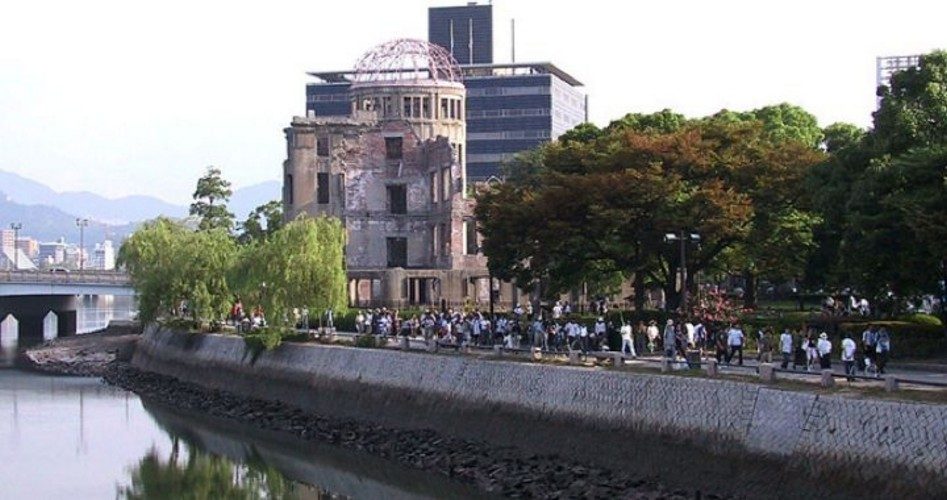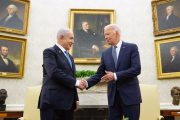
On May 27, President Obama became the first sitting American president to visit Hiroshima, Japan, the first place where nuclear weapons were used in warfare against a civilian population, when the United States dropped an atomic bomb on the city on August 6, 1945. During his visit, Obama met with two survivors of that devastating attack. The first of those survivors, Sunao Tsuboi, gripped Obama’s hand and held it until he had spoken to the president for some time.
“I held his hand, and we didn’t need an interpreter,” the 91-year-old Tsuboi, said later. “I could understand what he wanted to say by his expression.”
As he indicated before making the trip, Obama did not apologize for America’s use of the deadly weapons on Hiroshima and Nagasaki 71 years ago. However, he did use the visit to make a case for a world without nuclear weapons, saying: “We must have the courage to escape the logic of fear and pursue a world without them.”
{modulepos inner_text_ad}
Tsuboi is a co-chairman of the Japan Confederation of A- and H-bomb Sufferers Organizations (Hihon Hidankyo). A list of the organization’s objectives found on its website lists the expected measures to benefit the atomic bomb survivors. One of these was to obtain state compensation for the A-bomb damages. By this, the survivors mean the Japanese government, which they hold responsible for “having launched the war, which led to the damage by the atomic bombing.”
The last item listed was improvement of Japan’s “current policies and measures on the protection and assistance for the Hibakusha (the A-bomb victims — literally, “explosion-affected people.”)
However, the organization’s top priority, by virtue of being listed first, is obvious:
Prevention of nuclear war and the elimination of nuclear weapons, including the signing of an international agreement for a total ban and the elimination of nuclear weapons. The convening of an international conference to reach this goal is also part of Hidankyo’s basic demand;
The secretary general of Nihon Hidankyo, Tanaka Terumi, sent a letter to Obama on May 18, making a request of the president. The organization asked Obama “to meet the Hibakusha and hear their experiences of the indescribable hell on earth, learn first-hand the damage and aftereffects of the atomic bombing, and look at the A-bomb remnants and materials.”
Considering the near-total devastation of Hiroshima (killing 80,000 people) and Nagasaki (killing another 40,000) the above request seems responsible enough. One might have expected the Hibakusha to have requested an apology for the devastation from the American president, or even some form of compensation. However, almost the entire letter focused one objective: to create a world without nuclear weapons.
The letter quoted from Obama’s speech in Prague, Czech Republic, on April 5, 2009, in which he stated, “As the only nuclear power to have used a nuclear weapon, the United States has a moral responsibility to act…. So today, I state clearly and with conviction America’s commitment to seek the peace and security of a world without nuclear weapons.”
Tanaka’s letter also noted that the 70th Session of the UN General Assembly last year adopted a resolution entitled “Taking forward multilateral nuclear disarmament negotiations,” but lamented that none of the nuclear weapon states took part in either of the two sessions that the UN set up to create a legal framework for the elimination of nuclear arsenals. The letter urged Obama “to lead all the nuclear weapon states to follow the U.N. resolution and take part in the OEWG session.”
The letter also urged ratification of the Comprehensive Test Ban Treaty (CTBT) by the United States to achieve “a nuclear weapon-free, peaceful and safe world.”
During the visit to Hiroshima, Obama laid a wreath on a white pyramid in the city’s Peace Memorial Park (shown). Shortly afterwards, Japanese Prime Minister Shinzo Abe laid another wreath beside Obama’s on another pyramid. Pausing to reflect for a moment, the two leaders shook hands. As impressive as the ceremony was, it might have served as a more fitting memorial to the victims of the bombing 71 years ago if the parties involved had not succumbed to exploiting it to propagandize for nuclear disarmament, as if the weapons, themselves, rather than the policies of the governments involved, were responsible for the deaths.
As one example, a White House statement released on May 10 about Obama’s upcoming visit read: “Finally, the President will make an historic visit to Hiroshima with Prime Minister Abe to highlight his continued commitment to pursuing the peace and security of a world without nuclear weapons.” [Emphasis added.]
The illogic of making a connection between the existence of atomic weapons and the likelihood of nuclear warfare is made obvious when we consider that the bombings of Hiroshima and Nagasaki produced a world without nuclear weapons, because they exhausted our entire inventory of such weapons. (One other bomb had been used in the test at Alamagordo, New Mexico on July 16, 1945.)
Over the years of the Cold War, as the Soviet Union and the United States engaged in a nuclear arms race, their combined inventories of such weapons escalated to about 60,000 weapons in 1985. Since the only use of a nuclear weapon in warfare occurred when the world’s inventory was two weapons, and no nuclear weapons were used when the inventory was around 60,000, obviously mere numbers of nuclear weapons are not responsible for nuclear warfare. In fact, a good case might be made that the fear of mass destruction created by the existence of these weapons very likely deterred their use.
Most of the “disarmament” plans proposed by the world’s leaders over the years have not been about eliminating nuclear weapons, however. Despite the rhetoric coming out of the White House, it is impossible to put the nuclear genie back in the bottle. We will never see a world without nuclear weapons any more than we will ever see a world without conventional weapons — or bows and arrows, for that matter. Even if the world’s major powers could agree to such a plan, rogue states such as North Korea now possess the technology to produce them, and more are bound to join them.
Long before Obama went to Hiroshima and advocated that we must pursue a world without nuclear weapons, one of his predecessors in the White House was much more transparent in presenting his plan to accomplish nuclear disarmament. While that plan would have disarmed the world’s sovereign nations, however, it proposed to do so by turning these weapons over to a UN “peacekeeping” force. To recap this plan, it was outlined in a speech to the United Nations on September 25, 1961, by former President John F. Kennedy.
On that very day Kennedy formally submitted the U.S. State Department document Freedom From War: The United States Program for General and Complete Disarmament in a Peaceful World (State Department Publication 7277) to the UN. That document called for a disarmed world in which “no state would have the military power to challenge the progressively strengthened U.N. Peace Force.”
Only a few days after the United States bombed Hiroshima and Nagasaki, on August 13, 1945, U.S. Communist Party chief William Z. Foster wrote in an article appearing in the party newspaper Daily Worker proposing to give the UN control over the world’s nuclear weapons. Foster wrote: “If … the new atomic power which is a product of international science is to be directed to constructive uses, the general military control of it will have to be vested in the Security Council of the United Nations.”
That proposal offered by Foster set a pattern that was reinforced by the Kennedy plan unveiled at the UN in 1961, and remains alive in Obama’s latest commitment to “a world without nuclear weapons.”
Just prior to going to Hiroshima, Obama attended the G7 Summit Conference held in Ise-Shima, Japan. The White House press office posted a “G7 Ise-Shima Leaders’ Declaration” produced at that conference that endorsed the G7 Foreign Ministers’ Hiroshima Declaration on Nuclear Disarmament and Non-Proliferation and also supported the Nuclear Non-Proliferation Treaty.
Released immediately after those endorsements, the declaration stated:
We reaffirm the importance and necessity of realizing a strengthened, more effective and efficient United Nations and, to this end, note the importance of continued engagement on reforms of the United Nations, such as of the Security Council.
Ever since the atomic bombs dropped on Hiroshima and Nagasaki served as a living demonstration of the destructive power of nuclear weapons, the architects and supporters of the UN have capitalized on that horror to advocate a “strengthened, more effective and efficient United Nations” as the means of preventing a nuclear war.
As we saw during the darkest days of the Cold War, however, maintaining an inventory of nuclear arms that is second to none and the means to deliver them is an effective deterrent to nuclear war. It is not necessary to turn control of our nuclear weapons over to the UN in order to achieve peace.
Photo of Hiroshima Peace Memorial: Dan Smith
Related articles:
Dropping the Bomb: Why Did the U.S. Unleash Its Terrible Weapon?
Obama Visit to Hiroshima Highlights Commitment to a “World Without Nuclear Weapons”
70th Anniversary of the U.S. Atomic Bombing of Hiroshima
Review of Ron Paul’s New Book “Swords into Plowshares”
Dresden, Hiroshima, and Soviet Machinations
Remember WHAT about Pearl Harbor?



